10 Must-Visit Places in Jaisalmer
- By Seema
Jaisalmer is aptly called the “Golden City”. The entire city is dotted with golden-hued structures & historical monuments made with locally sourced yellow sandstone. You don’t have to go to any particular area to see it, it’s truly “golden” everywhere. Jaisalmer was established in the 12th century by Rawal Jaisal. The historical region is still drenched in past and you can experience architectural marvels, unique flavors, vibrant culture, and age-old traditions in every corner of the city. The Jaisalmer Fort sits on a three-peaked hill and towers over the entire town. The unusual sight of a huge fort standing tall in the center of the city is mesmerizing.
The elegant city would give you Arabian Night vibes as the narrow streets are filled with lively crowds, colorful shops, and vivid offerings. Located deep inside the Thar desert, Jaisalmer also provides easy access to breathtaking dunes. From visiting the striking Havelis & gorgeous Jain temples to spending the evening on the mystical sand dunes and exploring the abandoned villages– there are lots of exciting things to do in and around Jaisalmer. The city is small & compact and 3 days are just perfect to cover most of the famed sites. We have listed the 10 must-visit attractions in Jaisalmer to help you chalk out an itinerary for your trip to Jaisalmer.
Must-Visit Places in Jaisalmer:-
1. JAISALMER FORT, JAISALMER
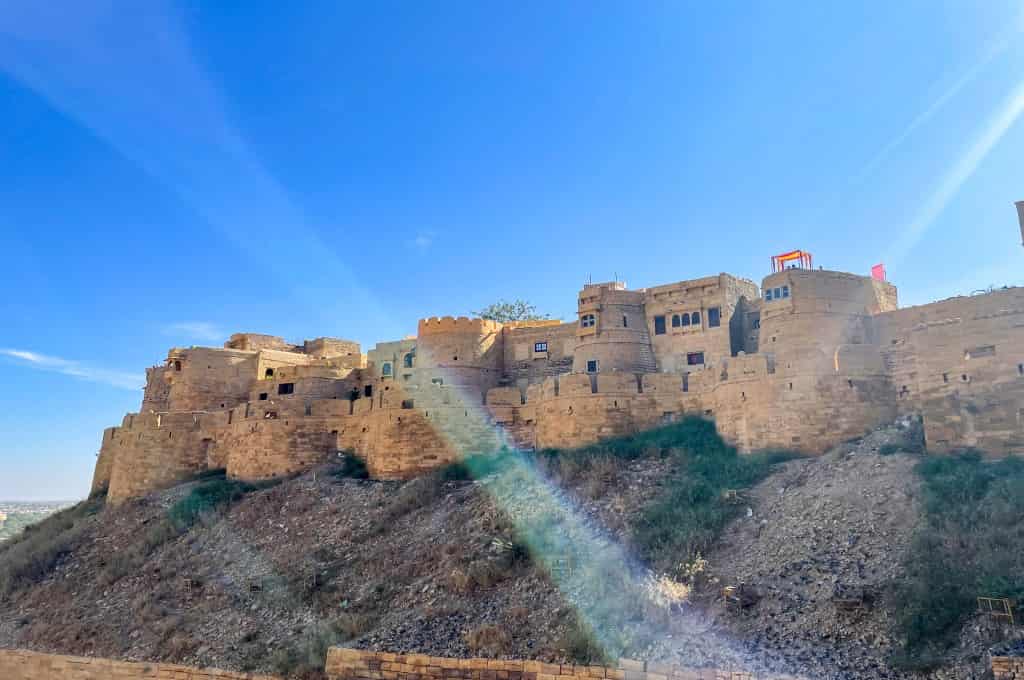
A visit to Jaisalmer would be incomplete without a visit to the Jaisalmer Fort. Jaisalmer Fort was built in 1156 AD by Bhati ruler Rawal Jaiswal. The massive yellow crenelated sandstone fort is located on Tirkuta Hill and stands tall displaying the Rajasthan architecture in all its glory. The UNESCO World Heritage Site has four majestic gates and 99 bastions around its imposing facades. Also known as Sonar Qila, the fort had managed to survive multiple attacks from different rulers over the years.
Jaisalmer Fort is fondly called the ‘Living Fort’ as locals live inside as well outside the fort walls – more than 3000 people live within the fort premises. The fort is abuzz with activities and there are several temples, cafes, museums, palaces, and shops inside the fort. Walking through the labyrinthine lanes, visiting the gorgeous Jain temples, dining at the rooftop eateries, and bargaining for the local handicrafts are a few of the things that you can do while visiting the Jaisalmer Fort. The grand fort stands at a height of 250 ft and offers panoramic views of Jaisalmer city owing to its altitude. At night, the fort is all lit up and glowing and a sight to behold.
Timing: Any Time
Entry Tickets: Free,
Time Required: 3-4 hours
2. GADISAR LAKE, JAISALMER
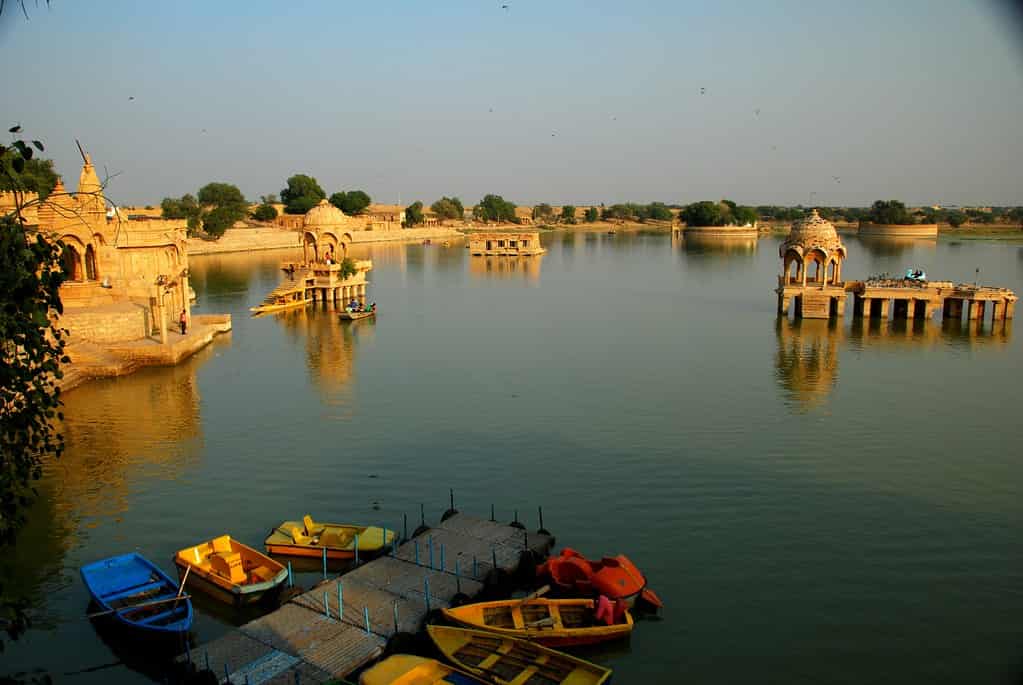
On the outskirts of Jaisalmer, lies the Gadisar Lake. The artificial lake is fringed by shallow ghats, Hindu shrines, and elegant cenotaphs. Lake Gadisar was built as a conservation reservoir under the rule of Raja Rawal Jaiswal in 1156 AD. It was later rebuilt by Gadsi Singh in 1367 AD. According to the locals, the man-made oasis was once the source of water for the entire parched region. Now the lake gets water from the Indira Gandhi Canal.
The idyllic getaway is one of the top attractions of Jaisalmer to spend a tranquil evening away from the bustling city – Watch a magical sunrise/sunset while boating in the shimmering lake, visit the sacred temples in the compound, and enjoy scenic views of the lake and the adjacent fort. Thirty minutes of boating will cost you less than 2 dollars. During winter, Gadisar Lake is heaven for bird lovers. The place is flocked by different species of migratory and exotic birds due to its proximity to Bharatpur Bird Sanctuary.
Timing: 8 am-7 pm
Entry Tickets: Free
Time Required: 1-2 hours
3. BADA BAGH, JAISALMER

Constructed in the 16th century, Bada Bagh has a huge collection of Chhatris (cenotaphs) made in honor of Maharajas of Jaisalmer. The construction of the Bada Bagh and the surrounding park was commissioned by Jait Singh but after his death, it was completed by his son Raja Lunakaran. From the 16th-20th century, more Chhatris were added to the Bada Bagh and it served as a crematorium for the members of the royal family.
The royal domes scattered across the park can be found in a variety of shapes – square, circular, and pyramid-shaped. Bada Bagh has other interesting attractions like a huge dam and a central pillar (Govardhan Stambh). The massive wind turbines lurking in the background add to the charm of the gardens. The picturesque Bada Bag is located around 5 km from the city center. The gardens are in a neglected state, but Bada Bagh is a sought-after location for pre-wedding shoots and Instagram clicks because of the dramatic setting of the honey-combed cenotaphs.
Timing: Open all days, 8 am-6 pm
Entry Tickets: Rs100 for Foreigners and Rs50 for Indians, Camera Fees: Rs100
Time Required: 1 hour
4. VYAS CHHATRI, JAISALMER
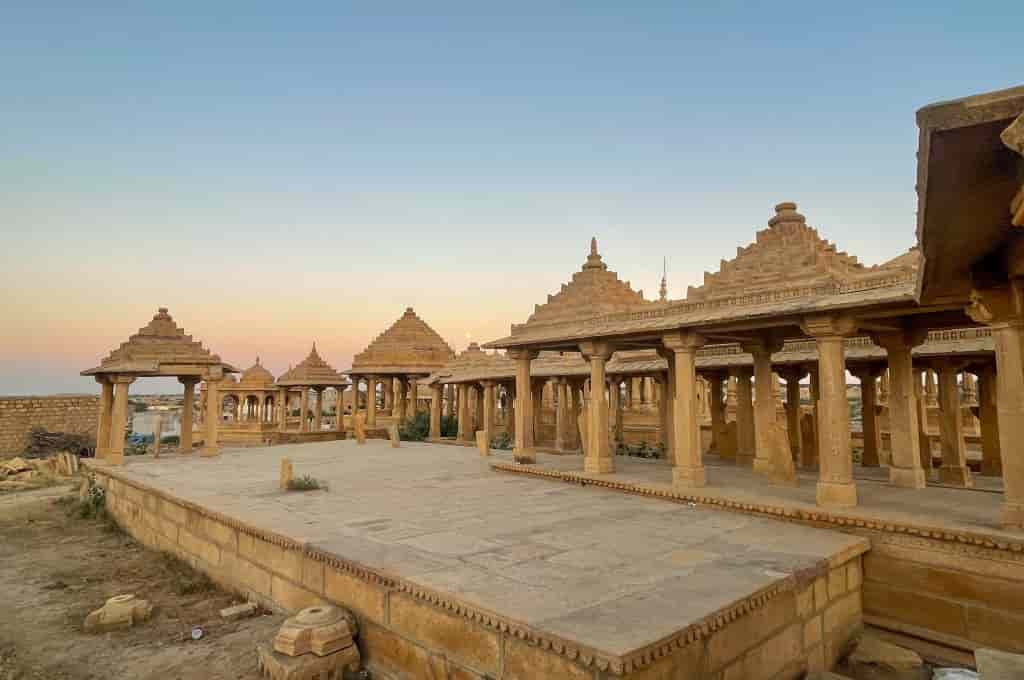
Another edifice of Rajasthani architecture, Vyas Chhatri is located 4kms away from the city center. It also boasts an array of intricately carved sandstone Chhatris. Built on an old Brahmin graveyard, it is dedicated to Sage Ved Vyasa, author of Mahabharata. His Chhatri is placed on the northern side of the structure. Vyas Chhatri is also known as the city’s sunset point as it offers panoramic views of Jaisalmer city and Sonar Fort. Built on a hill, Vyas Chhatri is an ideal place to visit if you want to watch a scintillating sunset in peace.
Timing: Open all days, 8 am-7 pm
Entry Tickets: Rs100 for Foreigners and Rs50 for Indians, Camera Fees: Rs100
Time Required: 1 hour
5. KULDHARA VILLAGE, JAISALMER

Situated 18 km from the city center, Kuldhara Village is popularly known as the Ghost Village of Jaisalmer. It was built in the 13th century and was habituated by the Paliwal Brahmins. However, the Kuldhara village and the neighboring 83 villages were abandoned overnight in the 19th century. The reasons why the whole town was abandoned still remain a mystery. According to folklore, a state minister Salim Singh wanted to marry the chief’s daughter. The villagers did not want to succumb to the minister’s demand and vanished in the dark to escape the dire consequences. It is believed that because of the villager’s curse, there has been no human settlement in the village for centuries. There is nothing much to see in the village but a few ruins of temples, step-wells, and other structures. The mystery surrounding the Kuldhara Village attracts tourists and they visit the village to get a closer look.
Timing: Open all days, 8 am-6 pm (recommended)
Entry Tickets: Rs10 For Car: Rs50
Time Required: 2-3 hours
6. JAIN TEMPLES, JAISALMER
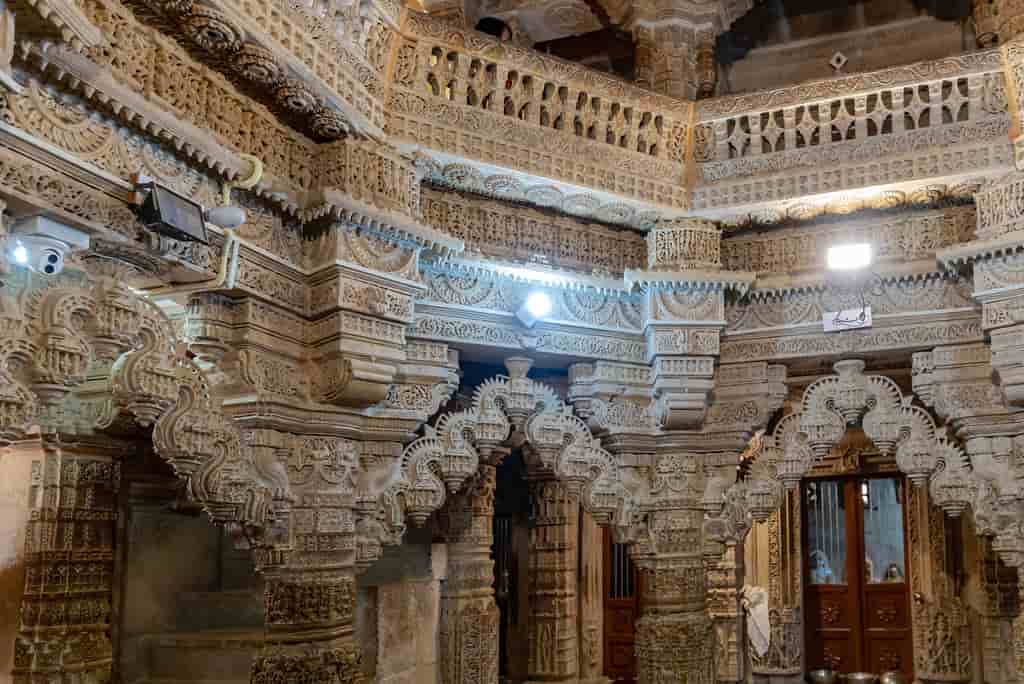
There is a group of seven Jain temples in Jaisalmer Fort that deserves a separate entry. The Jain temples, made entirely of yellow sandstone, were built in the 12th century and have great archeological value. The spectacular temples are built in the distinctive style of the Dilwara Temples of Mount Abu. The walls and the domes of the temples are adorned with intricately carved sculptures of human figures and animals. They are dedicated to Parshavnath, Rikhabdevji, Shambhadevji, and a few other Jain Tirthankara (Spiritual Leaders). The seven Jain temples are connected and are considered a very significant pilgrimage spot for the Jains. Visit them to soak the spiritual vibes and admire the exquisite and detailed carvings. Gyan Bhandar Library, located on the campus, possesses some old texts & rare manuscripts that are worth checking.
Timing: 8 am-12 pm
Entry Tickets: Free, Foreign Tourists Rs10; Camera: Rs50, Video Camera: Rs100
Time Required: 1-2 hours
7. PATWON KI HAVELI, JAISALMER
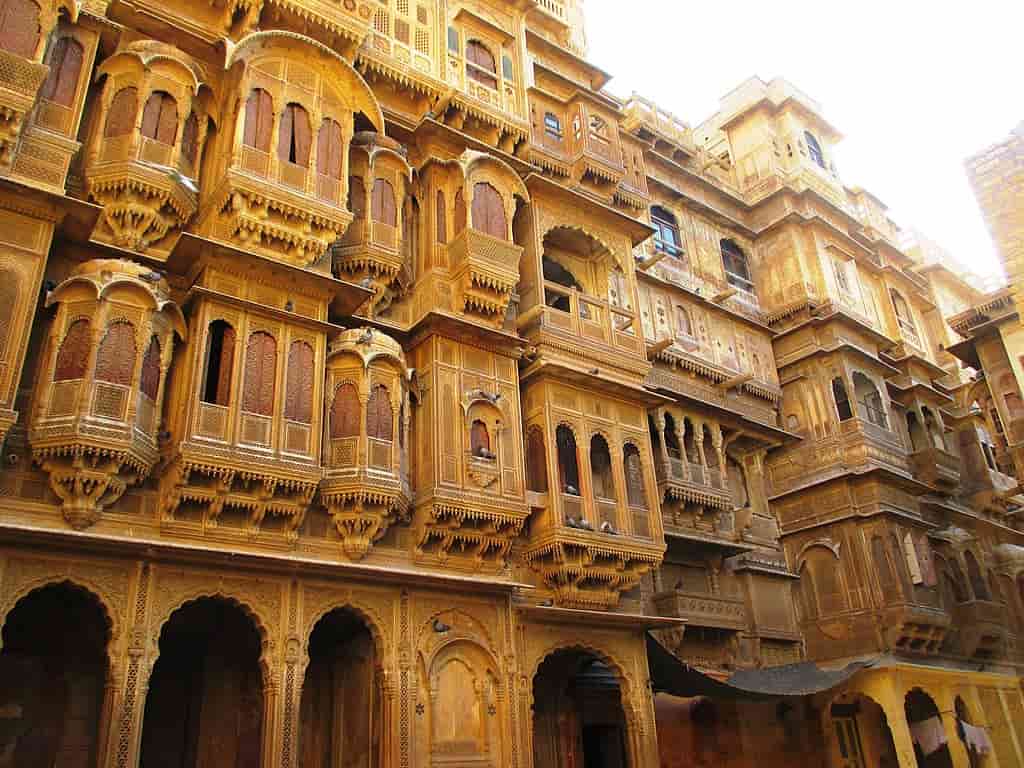
Jaisalmer is known for its stunning Havelis that are scattered all over the region. One of the oldest, largest, and most famous Haveli is the Patwon ki Haveli. It is a magnificent cluster of 5 small Havelis that were built between 1800 and 1860 by Guman Chand Patwa for his five sons. The Havelis has wooden ceilings, airy courtyards, and 60 balconies, each uniquely carved. The gateways, balconies, and arches of the 5 Havelis are decorated with beautiful mirrorwork, murals, and paintings. Each Haveli depicts a specific style making it different from the other Havelis. The interiors are as regal as the exteriors, and you will be impressed by the grandeur and architecture on display. One of the Havelis has been converted into a museum that displays rare artifacts, paintings, furniture, miniatures, stonework, and mirrorwork. The Havelis are located in a narrow lane. There is a compound in front of one of the Haveli that has been taken over by street vendors selling local handicrafts.
Timing: 9 am-5 pm
Entry Tickets: Indians: Rs20 Foreign Tourists Rs100; Camera: Rs50, Video Camera: Rs100
Time Required: 1 hour
8. NATHMAL KI HAVELI, JAISALMER

Another popular spot to visit in Jaisalmer is Nathmal ki Haveli, which was built in 1885 by two Muslim brothers. Maharaja Beri Sai commissioned it to serve as the residence of prime minister Diwan Mohata Nathmal, hence the name. The two buildings are very similar but they are not identical. The architecture is a perfect blend of Islamic and Rajputana architecture. The Haveli has a remarkably carved exterior and is guarded by two elephants. The highlight is the beautiful paintings on the first floor that have been made using 1.5 kg of gold leaf. The walls are engraved with horses, cattle, flora, etc., and would give you a glimpse of life in the bygone era. The illustration of cars and fans carved on the walls is mystifying as such luxuries did not exist in that period.
Timing: 8 am-7 pm
Entry Tickets: No Fees
Time Required: 30 minutes
9. SALIM SINGH KI HAVELI, JAISALMER
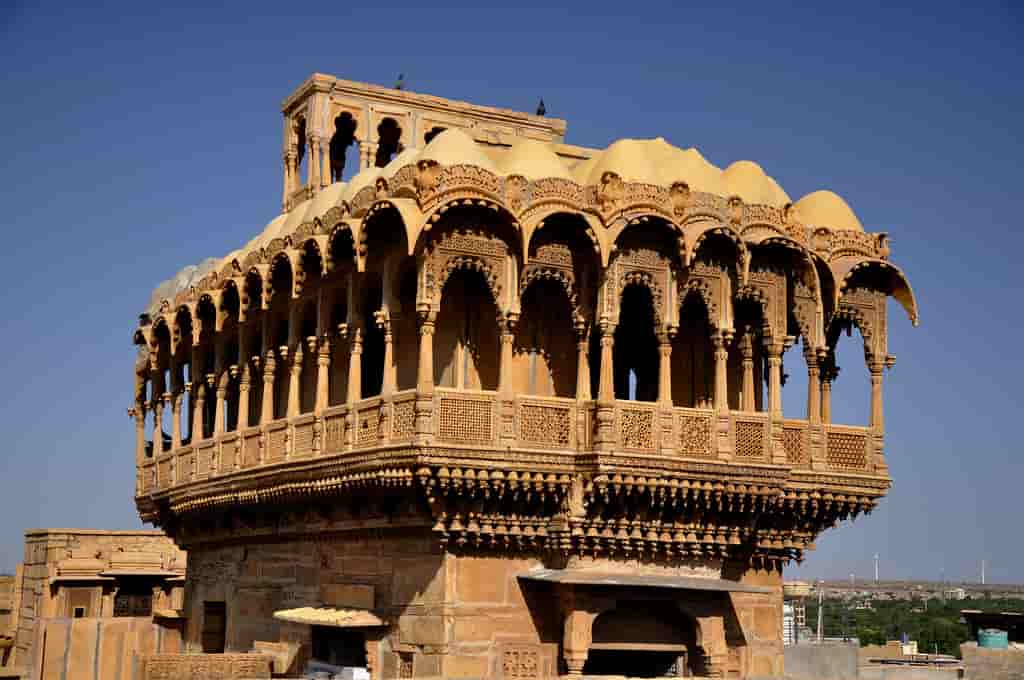
Another Haveli that makes it to the list is Salim Singh ki Haveli. It was constructed in 1815 by Salim Singh and is famous because of its Incredible silhouette, unique peacock-shaped roof, and elegantly designed pavilion. The entrance of the Haveli is guarded by pair of sandstone tuskers and looks royal. The front facade of the Haveli resembles a ship’s stern, so it is also referred to as Jahaz Mahal. It has around 38 balconies, each constructed with distinctive carvings and styles.
Timing: 8 am-6 pm
Entry Tickets: Rs20 Foreign Tourists Rs100; Camera: Rs50 Video Camera: Rs100
Time Required: 1 hour
10. SAM SAND DUNES, JAISALMER
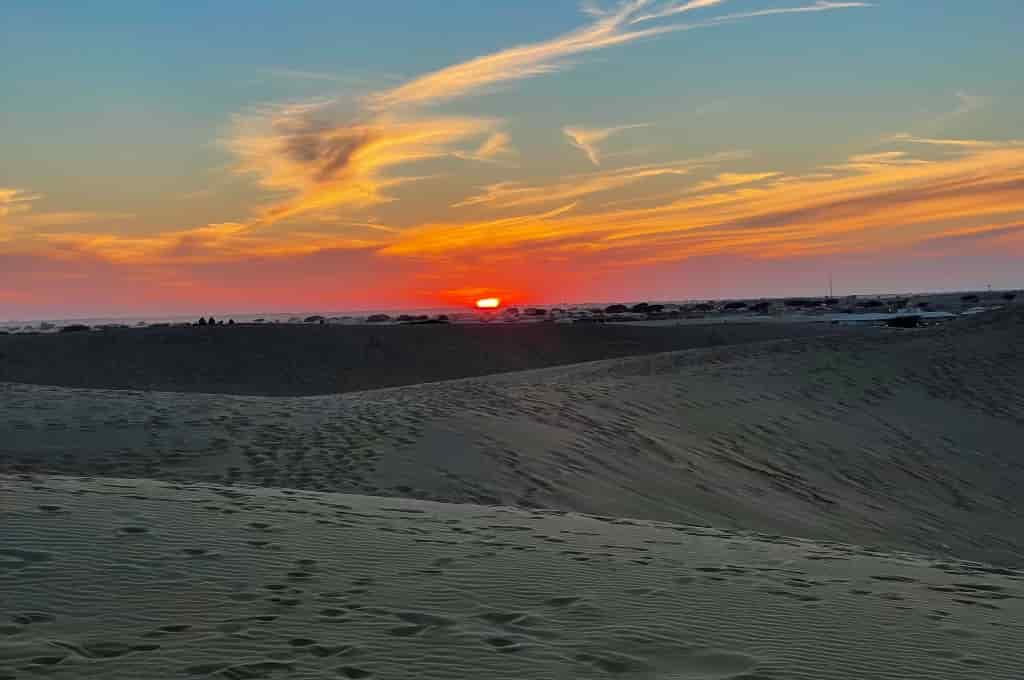
If you are visiting Jaisalmer, you have to explore the vast expanses of dunes stretching into the horizon. Sam Sand Dunes, located 42km from the city, is the best location to enjoy an authentic Desert safari. The dunes stretch for miles and miles, and you could easily get lost if you are not careful. You have the option to explore the sand dunes on a camel or in a jeep. Sunsets are truly magical as the crimson horizon reflects enchantingly on the golden dunes. If you want to spend the night under the star-lit sky and enjoy a complete desert experience, stay overnight at one of the countless camping sites in the area.
The Desert festival is celebrated in Feb-March. Folk dances, camel races, puppet shows, and other cultural events are organized at that time. If you are visiting the area during those months, don’t miss the opportunity to experience the vibrant culture of Rajasthan. If you are looking for sand dunes that are not as commercialized as Sam Sand Dunes, you can also opt for Khuri Sand Dunes. They are located around 40 km from the city and offer similar experiences sans the crowds and chaos.
Timing: Open All days
Entry Tickets: No Entry Fees. Camel Ride: Rs50-Rs200, Jeep Safari: Rs500-Rs1500
Time Required: Depends on the activities
How to spend three days in Jaisalmer?
Most of the attractions are within a short distance of each other, so it is quite easy to explore Jaisalmer in 3 days.
Day 1 – First-day itinerary depends on the time you arrive in Jaisalmer. Whatever may be your arrival time, you should still have time to check in at your hotel and enjoy the sunset at Gadisar Lake. If you reach Jaisalmer in the morning or early afternoon, you can check out some local shops or visit a couple of Havelis. Enjoy dinner on a rooftop to get incredible views of the Jaisalmer Fort.
Day 2 – Start your day with a visit to the Jaisalmer Fort. You can hire a guide who will help you navigate the narrow lanes of the fort so that you can make full use of your limited time. The Havelis are also within a walking distance and you can check them out easily. Leave around 4 pm for Sam Sand Dunes, so that you are in time to catch the eloquent sunset. You have the option to stay overnight in the camp or enjoy the evening programs and come back to Jaisalmer.
Day 3 – Next day’s itinerary will depend on where you spend your night. If you have slept overnight in Sam Sand Dunes, start early and stop at Kuldhara Village. The distance is 40 km. After spending a couple of hours in Kuldhara, leave for Jaisalmer. In case you have spent the night at Jaisalmer, take a round trip to Kuldhara village which is 18kms away from Jaisalmer. You will be back in Jaisalmer by the afternoon. After resting for a while (or maybe some last-minute shopping?), leave for Bada Bagh and Vyas Chatri to catch another gorgeous sunset. You can then catch a night train or leave the next morning by flight or car.
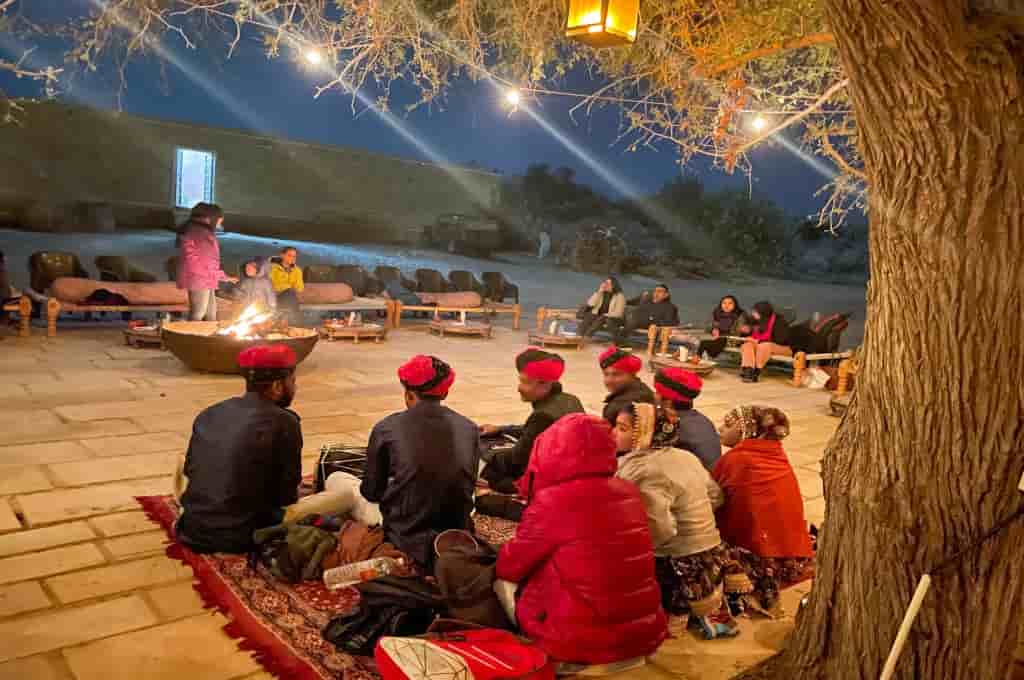
How to Travel in Jaisalmer?
Jaisalmer is a small city, so commuting is not an issue. You can easily catch an auto-rickshaw to go from one place to another. They will take anything from Rs50-Rs100. Another option is to rent a two-wheeler which is easily available. One of the best ways to explore Jaisalmer City is by walking. Jaisalmer Fort, the Havelis, local shops, and other attractions are all close by and you can conveniently explore them on foot. This is your chance to stumble upon hidden street shops and buy some local treasures. Meandering in crowded lanes is the best way to absorb the cultural heritage and lifestyle of Jaisalmer. The last option is, of course, taxis/private cars/tours. If you are not comfortable riding a two-wheeler, you will need a four-wheeler to reach Kuldhara Village and Sand Dunes. Ola and Uber are not available in Jaisalmer.
Things to know before you travel:
- The best time to visit Jaisalmer is from October to March when the weather is pleasant. Nights can be chilly. April-July is scorching hot and the worst time to visit Jaisalmer. There is hardly any rainfall in the region, so you can plan a vacation in August and September, but there will find limited activity and camping options to choose from.
- 2-4 days are enough to experience Jaisalmer and the neighboring areas.
- There are about 30 hotels inside the Jaisalmer Fort and it is possible to stay within the fort walls.
- Parasailing, quad biking, dune bashing, camel safari, jeep safari, and paramotoring are a few of the activities that you can enjoy in Jaisalmer
- Sadar Bazar, Pansari Bazar, Sonaron Ka Bass, Light of the East, and Manik Chowk are the best places to shop in Jaisalmer
- Silver jewelry, camel-wool shawls, applique-work bedcovers/cushions, fossil stones, carpets, and textiles with mirror work embroidery are some of the things you can buy in Jaisalmer.
- If you have the budget, a stay in Suryagarh is highly recommended.

This Post Has 10 Comments
Comprehensively covered Seema. Fantastic narration is all I can say.
Thank you for checking it.
So nice and wonderful of you in bringing out best of Jaisalmer certainly beautiful….. and we are blessed to have such a wonderful place golden place in our state and our country….. dhanyvad regards.
Keep it up.
God bless
Thank You
Like a travel through these places. Excellent 👍 Seema.
Must-Visit definitely
Fine travel write up with brilliant photographs.
Thank You
Very nice Seema
Thanks